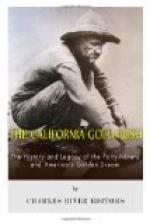The feverish life of the times reflected itself domestically. No live red-blooded man could be expected to spend his evenings reading a book quietly at home while all the magnificent, splendid, seething life of down-town was roaring in his ears. All his friends would be out; all the news of the day passed around; all the excitements of the evening offered themselves. It was too much to expect of human nature. The consequence was that a great many young wives were left alone, with the ultimate result of numerous separations and divorces. The moral nucleus of really respectable society—and there was a noticeable one even at that time—was overshadowed and swamped for the moment. Such a social life as this sounds decidedly immoral but it was really unmoral, with the bright, eager, attractive unmorality of the vigorous child. In fact, in that society, as some one has expressed it, everything was condoned except meanness.
It was the era of the grandiose. Even conversation reflected this characteristic. The myriad bootblacks had grand outfits and stands. The captain of a ship offered ten dollars to a negro to act as his cook. The negro replied, “If you will walk up to my restaurant, I’ll set you to work at twenty-five dollars immediately.” From men in such humble stations up to the very highest and most respected citizens the spirit of gambling, of taking chances, was also in the air.
As has been pointed out, a large proportion of the city’s wealth was raised not from taxation but from the sale of its property. Under the heedless extravagance of the first government the municipal debt rose to over one million dollars. Since interest charged on this was thirty-six per cent annually, it can be seen that the financial situation was rather hopeless. As the city was even then often very short of funds, it paid for its work and its improvements in certificates of indebtedness, usually called “scrip.” Naturally this scrip was held below par—a condition that caused all contractors and supply merchants to charge two or three hundred per cent over the normal prices for their work and commodities in order to keep even. And this practice, completing the vicious circle, increased the debt. An attempt was made to fund the city debt by handing in the scrip in exchange for a ten per cent obligation. This method gave promise of success; but a number of holders of scrip refused to surrender it, and brought suit to enforce payment. One of these, a physician named Peter Smith, was owed a considerable sum for the care of indigent sick. He obtained a judgment against the city, levied on some of its property, and proceeded to sell. The city commissioners warned the public that titles under the Smith claim were not legal, and proceeded to sell the property on their own account. The speculators bought claims under Peter Smith amounting to over two millions of dollars at merely nominal rates. For example, one parcel of city lots sold at less than ten cents




